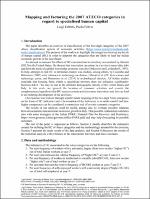Chapter Mapping and factoring the 2007 ATECO categories in regard to specialised human capital
| dc.contributor.author | Fabbris, Luigi | |
| dc.contributor.author | Feltrin, Paolo | |
| dc.date.accessioned | 2022-06-01T12:20:43Z | |
| dc.date.available | 2022-06-01T12:20:43Z | |
| dc.date.issued | 2021 | |
| dc.identifier | ONIX_20220601_9788855184618_548 | |
| dc.identifier.issn | 2704-5846 | |
| dc.identifier.uri | https://library.oapen.org/handle/20.500.12657/56363 | |
| dc.description.abstract | The paper describes an exercise of classification of a subset of five-digit categories of the 2007 ATECO classification system of economic activities. The analysis is grounded on the hypothesis that economic sectors can be clustered according to the competency level required to human resources recently working in industries or services in Italy. The analysis may be useful to evaluate a possible relationship between economic development and education. The analysis consisted of a mapping and then a clustering of the Ateco categories according to the between-distribution dissimilarity of any possible couple of categories. The basic idea was to highlight the Ateco categories that require either more education than others or more education and working experience (human capital) than others, pinpointing, in particular, the categories that require larger percentages of tertiary education and those residing close to territorial hubs. The competency level was measured with a combination of educational attainment and in-service experience of Italian employees, as defined by Istat, the Italian statistical institute. The employees’ educational level was evaluated with the frequency distribution of five (ordinal) classes of education of people employed in 2018 and 2019 in both private and public establishments and offices; the working experience with a logarithmic transform of the average number of in-service years of employees. The analysis highlighted both a sort of input-related classification of the economy and a supply-side classification of the labour market. The results are in line with the theory of the existence of a cluster of creative companies residing close to territorial hubs. | |
| dc.language | English | |
| dc.relation.ispartofseries | Proceedings e report | |
| dc.subject.other | Category Mapping | |
| dc.subject.other | Ateco 2007 | |
| dc.subject.other | Clustering economic categories | |
| dc.subject.other | Human capital | |
| dc.subject.other | Creative companies | |
| dc.title | Chapter Mapping and factoring the 2007 ATECO categories in regard to specialised human capital | |
| dc.type | chapter | |
| oapen.identifier.doi | 10.36253/978-88-5518-461-8.18 | |
| oapen.relation.isPublishedBy | bf65d21a-78e5-4ba2-983a-dbfa90962870 | |
| oapen.relation.isbn | 9788855184618 | |
| oapen.series.number | 132 | |
| oapen.pages | 6 | |
| oapen.place.publication | Florence |

